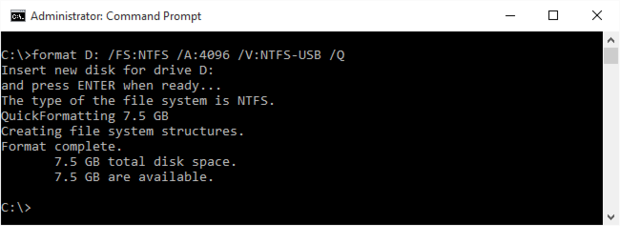

That's it! Let me know if this guide has helped you by leaving your comment about your experience.

Finally, type exit to close the DiskPart tool and then close the command prompt window. When the format is completed, assign a drive letter on the formatted partition, by giving this command:ĩ. Then format the newly created partition, with this command:Ĩ. When the "low level format" is complete, type the following command to create a partition on the disk:ħ. The "clean all" command takes very very long time to complete, so be patient. To completely erase all partitions (and the data), by writing zeros on every sector (low level format), type: clean allġ.To delete all partitions and data on the drive, type: clean.Now according, what you wish to do, give one of the following commands (and press Enter): So the command in this case is: select disk 1ĥ. At this example, we want to format the "Disk 1" (see screenshot below). * Note: Where " DiskNumber " = The number assigned to the disk that you want to format.Į.g. You can easily find out which disk is in the list from its size in GB (Gigabytes). From the listed disks, locate which one is the disk that you want to format.

In the administrative command prompt window, type:ģ. To format a hard drive using the DISKPART utility:ġ.
How to Format a Hard Disk using DISKPART. : To format the disk D: with the NTFS file system and to write zeros in every sectors twice type: format D: /fs:NTFS /p:2 By filling with zeros a drive (hard disk, USB, Memory card, etc.), you ensure that all it's stored data will be erased permanently and no one can retrieve the data from it in any way. Keep in mind that the command takes very long time to complete, even for one pass of writing zeros.Ģ. Where " n" = The number of times that you want to write zeros in every sector.
To preform a LOW LEVEL FORMAT on a hard drive, in order to securely erase it by writing zeros on every sector, type: format X: /FS: Filesystem /p: n *ġ. To format the disk D: in the exFAT file system: format D: /fs:exFAT. To format the disk D: in the FAT32 file system: format D: /fs:fat32. To format the disk D: in the NTFS file system: format D: /fs:NTFS. * Note: In " Filesystem" you can specify one of the following file systems: FAT, FAT32, exFAT, NTFS or UDF. To format a hard disk in a specific FILE SYSTEM in command prompt, type: format X: /FS: Filesystem *. To QUICK FORMAT a hard drive in command prompt, type: format X: /q. When asked to "enter the current volume label", type the volume label mentioned after typing the above command and press Enter.Į.g If the want to format the disk D:, with Volume Label "New Volume", then type these commands in order: To format the hard drive (to erase the data it contains), give the following command and press Enter:ģ. If you want to format the drive D:, then type: vol D:Ģ. Be very careful when selecting the hard drive to format.Į.g. Where " X" = the drive letter of the disk that you want to format.Ģ. Find out the "Volume Label" of the drive that you want to format, by typing this command: *ġ. How to Format a HDD, SSD Drive in Command Prompt (CMD).ġ. Now, use one of the two following methods to format the drive: Right click on the command prompt (result) and select Run as Administrator.Ģ. In the Search box type: cmd or command promptĢ. How to Format a Drive from Command Prompt or DISKPART.ġ. Related article: How to Securely Wipe a Hard Drive or Computer before selling. Keep in mind, that you can use the same instructions to format a hard disk, from the Windows Recovery Environment (WinRE) In this guide you 'll find detailed instructions on how to format or to securely wipe a hard drive (HDD or SSD), from the Command Prompt with the "Format" command, or by using the "DiskPart" command line tool, in Windows 10, 8 or 7 OS. when the file system on the disk is corrupted or because the hard drive is in RAW format, etc.). But, sometimes it is impossible to delete or format a partition or volume on a hard disk by using the Disk Management tool, because the hard disk is not recognized by Windows for a variety of reasons. In all Windows versions, the classic and most common method to delete, create and format partitions or hard disks is by using the Disk Management tool. 
By formatting a hard drive, you will delete all the data it contains, so make sure that you already have a copy of the data it contains. In this tutorial you ill find step by step instructions on how to format a hard drive in command prompt with the FORMAT command or the DISKPART tool.








 0 kommentar(er)
0 kommentar(er)
